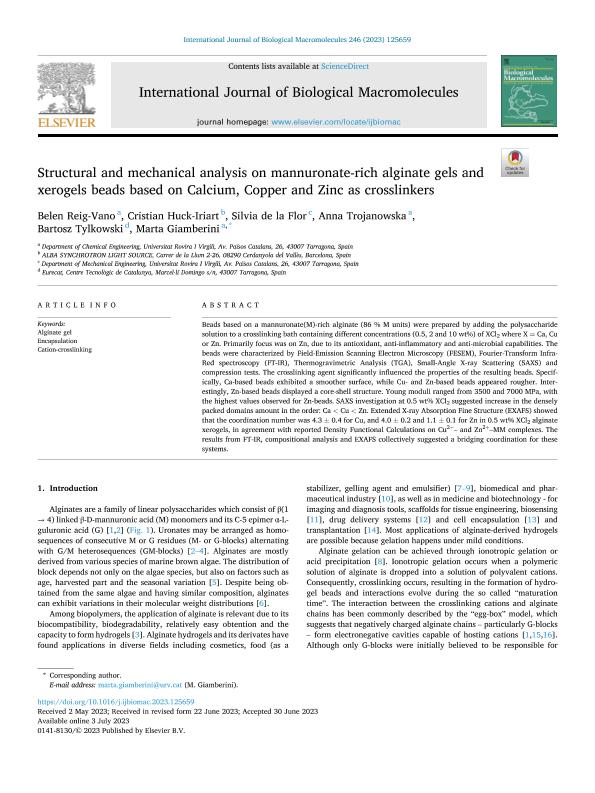Artículo
Structural and mechanical analysis on mannuronate-rich alginate gels and xerogels beads based on Calcium, Copper and Zinc as crosslinkers
Reig Vano, Belen; Huck Iriart, Cristián ; de la Flor, Silvia; Trojanowska, Anna; Tylkowski, Bartosz; Giamberini, Marta
; de la Flor, Silvia; Trojanowska, Anna; Tylkowski, Bartosz; Giamberini, Marta
 ; de la Flor, Silvia; Trojanowska, Anna; Tylkowski, Bartosz; Giamberini, Marta
; de la Flor, Silvia; Trojanowska, Anna; Tylkowski, Bartosz; Giamberini, Marta
Fecha de publicación:
08/2023
Editorial:
Elsevier Science
Revista:
International Journal of Biological Macromolecules
ISSN:
0141-8130
Idioma:
Inglés
Tipo de recurso:
Artículo publicado
Clasificación temática:
Resumen
Beads based on a mannuronate(M)-rich alginate (86 % M units) were prepared by adding the polysaccharide solution to a crosslinking bath containing different concentrations (0.5, 2 and 10 wt%) of XCl2 where X = Ca, Cu or Zn. Primarily focus was on Zn, due to its antioxidant, anti-inflammatory and anti-microbial capabilities. The beads were characterized by Field-Emission Scanning Electron Microscopy (FESEM), Fourier-Transform Infra-Red spectroscopy (FT-IR), Thermogravimetric Analysis (TGA), Small-Angle X-ray Scattering (SAXS) and compression tests. The crosslinking agent significantly influenced the properties of the resulting beads. Specifically, Ca-based beads exhibited a smoother surface, while Cu- and Zn-based beads appeared rougher. Interestingly, Zn-based beads displayed a core-shell structure. Young moduli ranged from 3500 and 7000 MPa, with the highest values observed for Zn-beads. SAXS investigation at 0.5 wt% XCl2 suggested increase in the densely packed domains amount in the order: Ca < Cu < Zn. Extended X-ray Absorption Fine Structure (EXAFS) showed that the coordination number was 4.3 ± 0.4 for Cu, and 4.0 ± 0.2 and 1.1 ± 0.1 for Zn in 0.5 wt% XCl2 alginate xerogels, in agreement with reported Density Functional Calculations on Cu2+– and Zn2+–MM complexes. The results from FT-IR, compositional analysis and EXAFS collectively suggested a bridging coordination for these systems.
Palabras clave:
ALGINATE GEL
,
CATION-CROSSLINKING
,
ENCAPSULATION
Archivos asociados
Licencia
Identificadores
Colecciones
Articulos (ITECA)
Articulos de INSTITUTO DE TECNOLOGÍAS EMERGENTES Y CIENCIAS APLICADAS
Articulos de INSTITUTO DE TECNOLOGÍAS EMERGENTES Y CIENCIAS APLICADAS
Citación
Reig Vano, Belen; Huck Iriart, Cristián; de la Flor, Silvia; Trojanowska, Anna; Tylkowski, Bartosz; et al.; Structural and mechanical analysis on mannuronate-rich alginate gels and xerogels beads based on Calcium, Copper and Zinc as crosslinkers; Elsevier Science; International Journal of Biological Macromolecules; 246; 8-2023; 1-15
Compartir
Altmétricas



